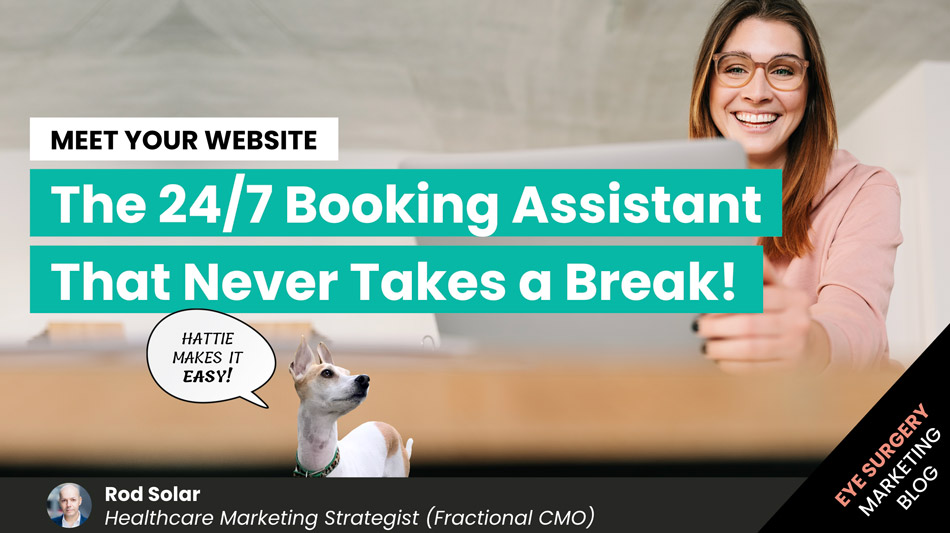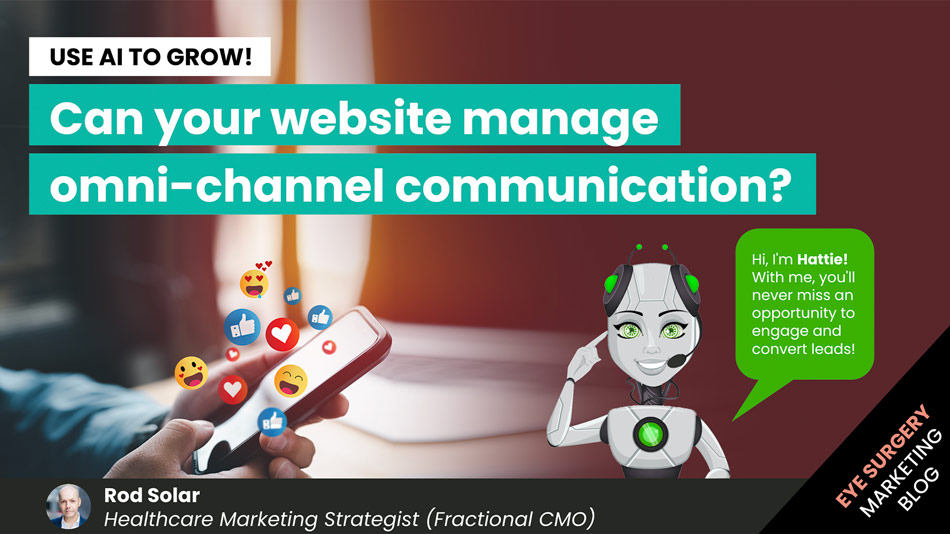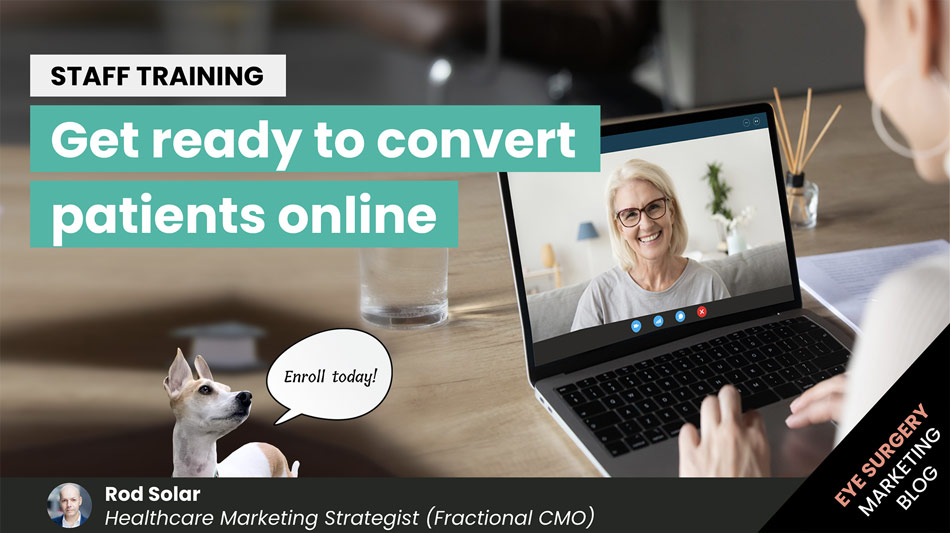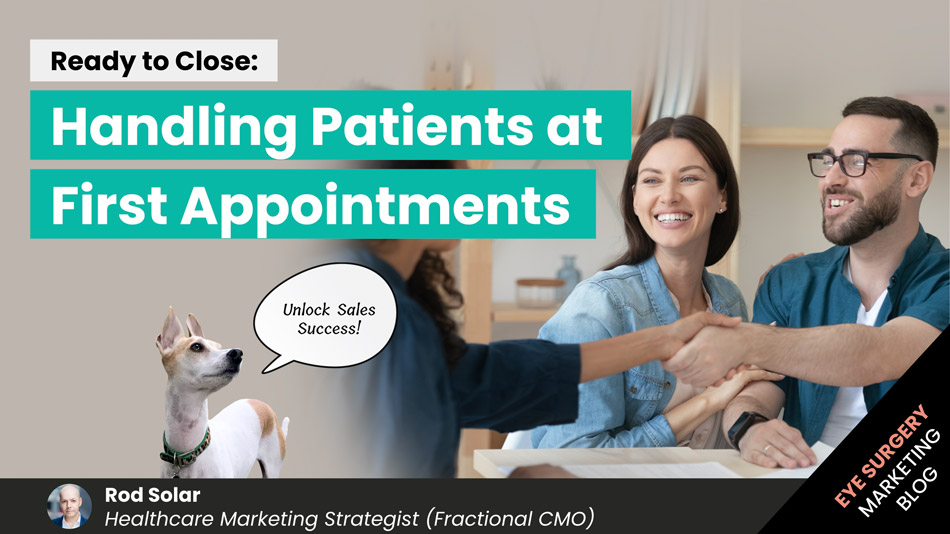What is patient-centric marketing?
Rod Solar:
So today, I wanted to talk about patient-centric marketing. And I think the reason this is coming up for me right now is that I’ve been working with a few customers recently, despite my sharing this information, many years ago, I first did a presentation at ECRS regarding this. I think it was called “Copywriting for Conversions”.
And in that presentation, I shared how to do patient-centric marketing. And when I was doing that, I had the feeling that the message was getting out there.
It was starting out. It’s not – by the way – entirely my message. I’m not the only one who thinks this way.
First, this information is available in lots of different pieces of literature, lots of different webinars and courses on this are led by very, very prolific gurus and writers and other people who specialise in this type of thing.
So patient-centric marketing is very important. Despite my talking about it back in 2018, this being a very common concept and me writing about it a lot, I feel like I still need to come back and talk about it more.
So I’m going to do that. I’m going to do that today. I’m going to talk about patient-centric marketing and tell you a little bit about how you can use patient-centric marketing when it comes to you writing specifically for all of your marketing materials.
You may not be writing for your marketing materials. You may not be the writer. You may have somebody who you hire to do this.
Perhaps you have an agency, maybe you hire a writer to do this, a copywriter, or perhaps you have somebody who helps you that’s inside the clinic?
So it could be lots of different people who help you out. But the point here is that you always have to think about patient-centric marketing whenever you’re writing or putting anything together; when it comes to marketing.
So this is what I want to talk about today. Now, the thing here is what I want to get across is that:
Pretty websites don’t sell things
And that goes for ads. And that goes for social media posts. And that goes for videos. How pretty something is, how nice it looks, helps because we like to look at pretty things.
We like to be visually impressed. We like to be alerted that something makes us feel good by looking at it. We’re visual creatures.
But when it comes to selling things, when it comes to getting people to take action; words do that. So pretty websites, pretty ads, pretty social media posts, pretty signs. They don’t sell things. Words sell things. So you need to focus on words. It’s very important.
Patient-centric or Brand-centric?
So I’m going to show you a couple of websites here. Now, these websites are a little out of date, but that’s okay because they still support the timeless principles.
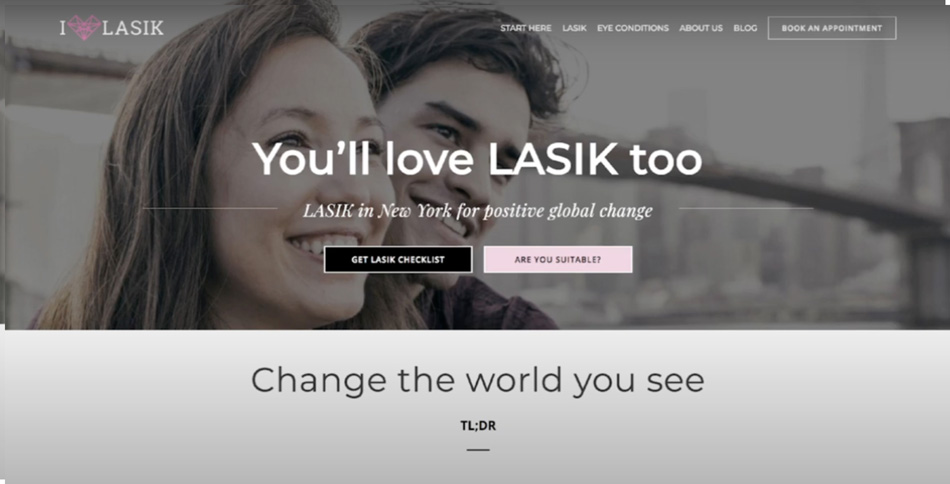
I’m going to share with you today. So this is one of them. And later on, I’m going to show you these and ask you a question about these.
I’m going to ask you about whether they’re patient-centric or whether they’re brand-centric. And I want, I’m going to ask you to look at the website again, and consider whether which one of those it is. Okay?
And you might want to think about that now. Is this patient-centric or is it brand-centric? Okay? Let’s have a look at another one.
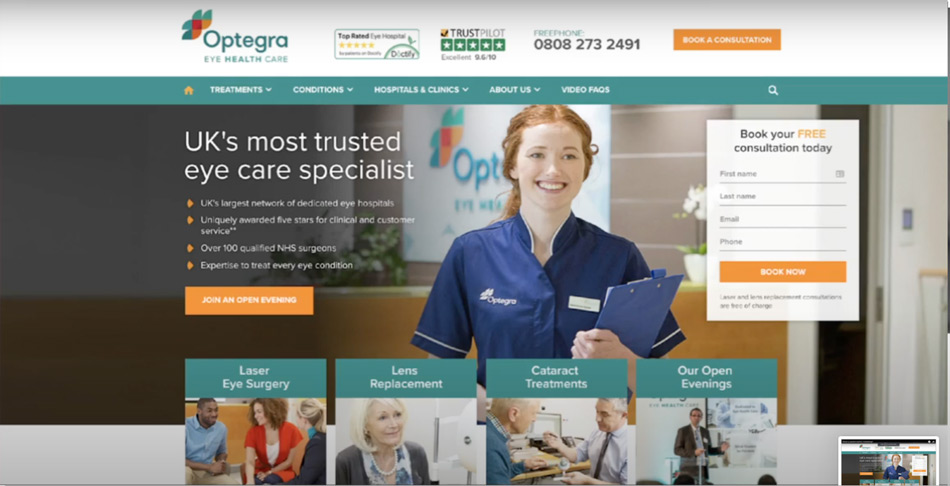
So the last one was in New York. This one’s all over the UK. It’s a bit of an old version, but honestly it hasn’t changed that much. Not in the way that I’m talking about, in terms of being one way or the other. Is this patient-centric, or is this brand-centric? All right?
So you have a look at that real quick. Is it patient-centric or is it brand-centric?
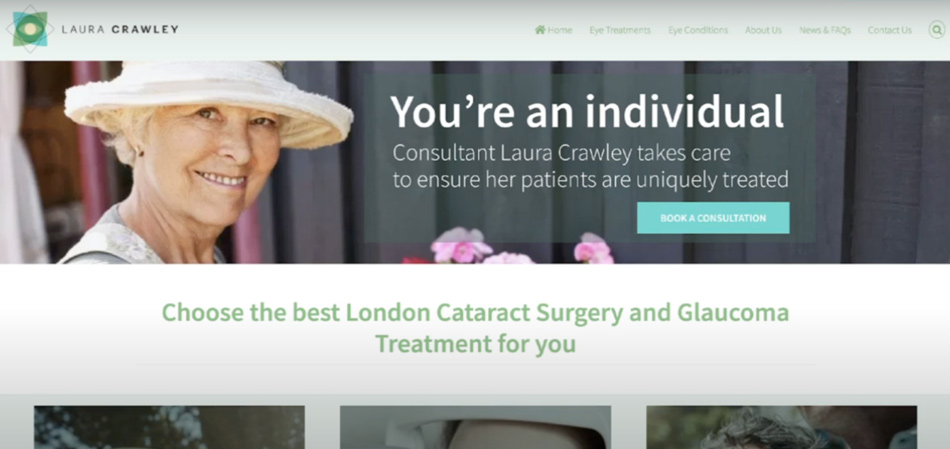
And have a look at this one: Is this patient-centric? or brand-centric?
This is a consultant ophthalmologist who operates a private practice in the UK. Okay?
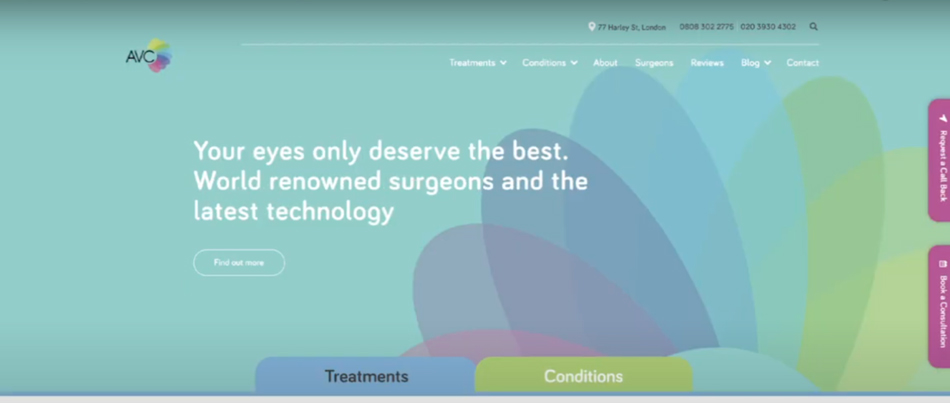
And the next one: patient-centric or brand-centric? This one’s out of business.
No longer existing. But yeah, the website I captured many, many years ago, not a customer of ours. Just question: patient-centric or brand-centric?
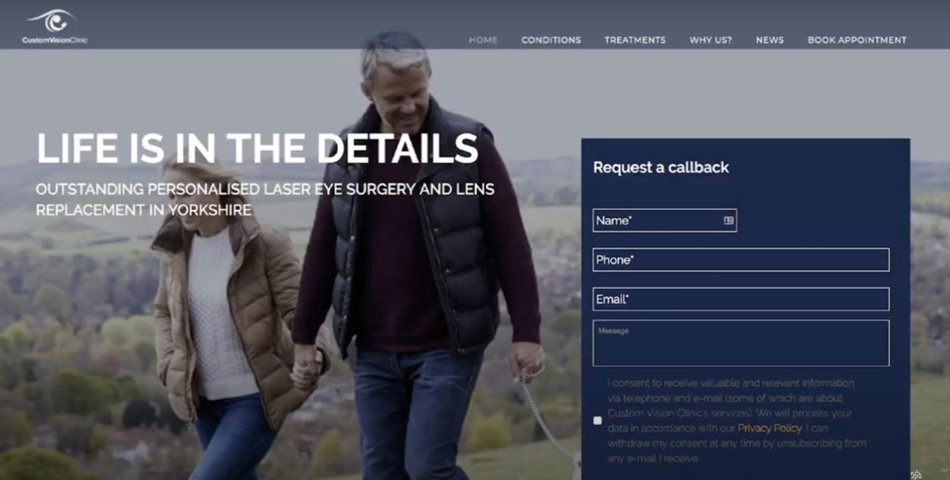
Here’s another one. ‘Life is in the details’. This is a Custom Vision Clinic up in Leeds (a current customer of ours).
Patient centric or brand centric? (I might’ve given you a hint there).
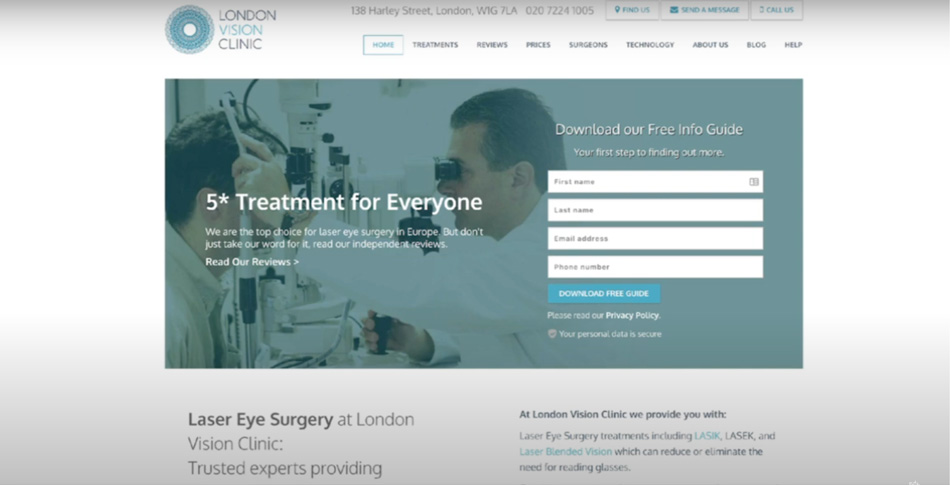
Okay. Here’s another one. London vision clinic: long-term customer of ours. This is a little bit of a trick question.
Is it patient centric or is it brand centric? Okay?
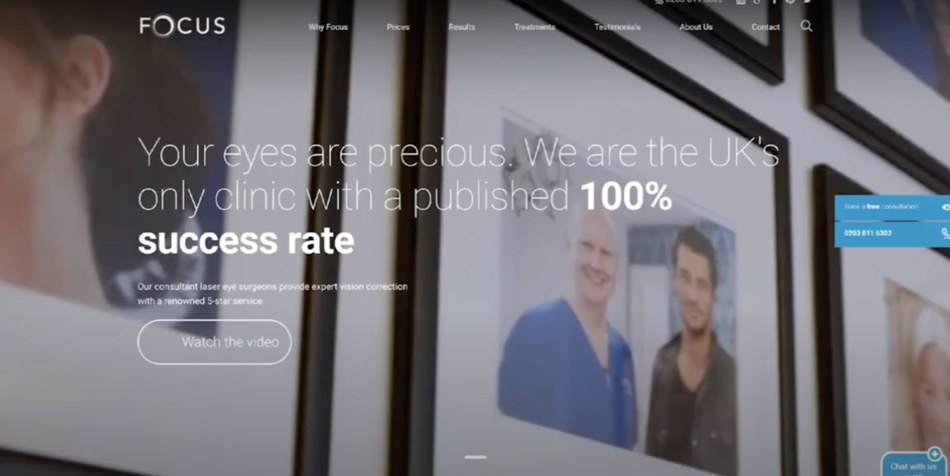
Here’s another one (also a former customer).
Patient centric or brand centric?
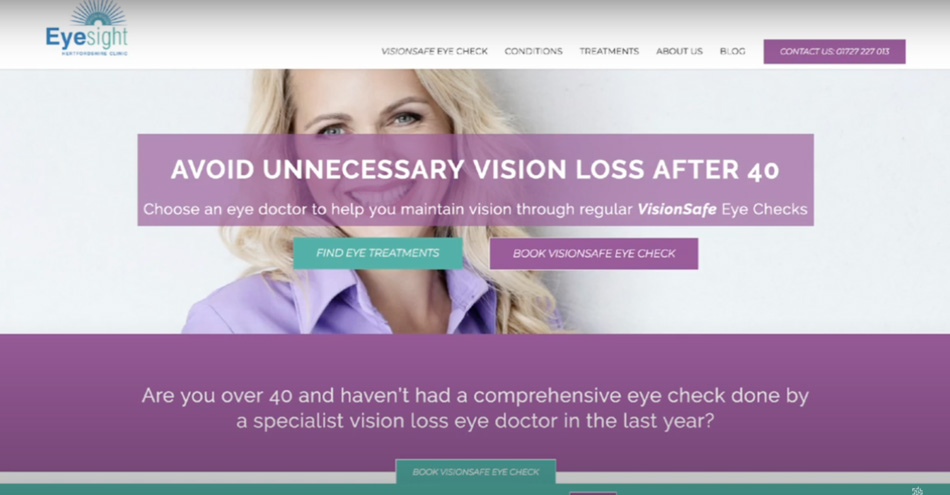
Okay. All right. Last one, last one.
Patient centric or brand centric. Right? Last two were Harley street clinics, laser eye surgery.
This one is up in St. Alban’s and doing a general ophthalmology, AMD, glaucoma, that type of thing. Retinol.
How to write… or What to write?
So how to write? or what to write? This is the question. How do you write for a website and what do you write about, or how do you write for an ad?
What do you write about? This is a fundamental question.
So when you’re putting something together (like an advertisement), the very first thing you want to do is ask yourself:
What do I want the person to do?
When you think about what it is that you want (the person who’s seeing the advertisement or the website to-do), you’re unlikely to achieve that with a picture, right?
You’re more likely to achieve that with instructions. Written instructions or verbal instructions. So how to write or what to write?
Writing the right things well, is better than writing the wrong things perfectly
Okay. What does that mean? Well;
You don’t have to be an artist when it comes to writing things.
You just have to write clearly about the right things, because people listen and read the right things. They don’t pay attention to the wrong thing.
So you can write the wrong things really, really well. You can create beautiful prose. All right? That’s almost as pretty as poetry, but if it’s the wrong thing, no one’s going to pay attention. So no matter how ‘perfect’ it is, it doesn’t matter. It won’t reach the goal.
Okay.
Writing the right things well is better than writing the wrong things perfectly.
That’s a take-home message.
People want to survive and they want to thrive
Why am I telling you this?
Well, we need to consider what state people are in when we’re sending messages to them. Right? And whether that’s email social media websites.
Like who do they care about? Who do these people care about most? Right? Well, who do you care about most?
You can say, I’m a selfless individual. However, at the end of the day, you care about you. You spend most of your time thinking about you, right?
Your thoughts, your feelings, your pressures, your challenges, your goals, your hopes, your aspirations, your fears, your frustrations.
People are the same.
People who aren’t you, also are thinking about themselves. They’re not thinking about you.
Don’t fall into that trap thinking that the whole world revolves around you, because it doesn’t. People out there are thinking about themselves.
The whole world revolves around them, for them. Okay? So they want to survive and they want to thrive. Those are the two fundamental things that people want to do. Right?
When you look at the main things that people want to do, they want to survive. They want to thrive.
People don’t want to burn unnecessary calories
What they don’t want to do is they don’t want to burn unnecessary calories. They don’t want to waste effort.
So nobody out there wants to try to figure out what it is that you’re trying to communicate. Right? They want to survive and thrive. So if it doesn’t really hit them on one of those two levels, if it doesn’t help them survive, if it doesn’t help them thrive, they lose focus.
They’re not interested. They don’t want to burn necessary calories trying to figure out what you’re trying to say. So that’s a big, big rule here. Right?
Keep it super simple. Don’t make them burn unnecessary calories.
Your job is to make your message about something that helps the customer survive and thrive and to do so in such a way that they can understand it without burning too many calories.
So people are lazy. They don’t want to make the effort. So your job is to make the effort for them and work really hard to make something super clear that it helps them survive or that it helps them thrive.
And if it doesn’t do those two things, they will not waste their effort on you and what you have to say. Sorry to tell you, but that’s true.
It doesn’t matter how important it is to you. It only matters how important it is to them.
We use way too many words, talking about things that we care about and not enough words talking about what our customers care about.
I see this all the time. Most recently, I was watching my team work with a customer who was really, really, really excited about their grand opening.
Makes sense. Right? Yeah, totally makes sense; [as to] why they would be excited about their grand opening.
I think if you were in their position, it’s only natural.
You too would be very excited about your grand opening. I’ve been there. When I have been launching new products, preparing for my talks, writing new posts, I’m really excited!
And I think everybody else is going to be just as excited about that.
But the reality is most people don’t care.
And that goes for me too. Nope. Most people don’t care! About what I’m thinking about, or what I’m talking about.
They only care about what helps them survive and what helps them thrive. So if I don’t talk about those things, if I don’t talk about the things that they care about, they’re not going to listen.
And if I confuse them, I will lose them.
Okay? So if you do the same, if you confuse them with what you’re trying to get across. If you’re talking about too many things that they don’t care about – I’ll give you some examples.
NOTE: The best way to answer that nagging question about practice growth or marketing or patient volume in the back of your mind is to book a free 15-minute compatibility call. Get some options and go away with a clear idea of what’s possible.
Confuse them and you will lose them.
No one cares.
No one cares about these things apart from that tiny, tiny vocal minority of people who lead you astray, lead you as straight to think that many people do. So don’t fall into that trap. Don’t get into the things that might confuse them, or you will simply lose them.
And they will go to the person who doesn’t confuse them, who basically says to them, “here’s how you survive. Here’s how you thrive.”
So don’t do that! And I still see too many people doing that. Even my customers!
You know, I had a customer, most recently, [who] did very, very well. Increased their business five fold, and they left us.
Not a problem. That’s okay. People leave us, it happens. We’re not for everybody, all the time. Here’s the reason they cited:
We didn’t talk enough about the laser. Now that’s interesting. So why would I talk about the laser when that doesn’t help anyone? Okay?
And they’re like, “well, you know, we’re the only one with our laser in our town and that’s our point of difference”.
Well, if that was your point of difference, and I haven’t been talking about the laser for the last two years, while I’ve grown your business by five times, what makes you think that if I start talking about the laser, now I’m going to grow it better?
We didn’t need to talk about the laser to grow five times. If I talked about the laser, I would have confused them.
I would have lost them. And there’s a really good chance that the business would not have grown five times. So yeah, you confuse them and you lose them.
And I still have people (despite me working with them for many, many years), still fall back into the trap – thinking what people care about is what they care about.
Right? And we always fall into this trap constantly! We think, well, why in the world wouldn’t everybody care about the things I care about?
Because they’re different. Because they’re not you.
People don’t buy the best products
Newsflash. People don’t buy the best products. You might think to yourself, “I’m the best surgeon on the planet.
“I’m the best surgeon in my country. I’m the best surgeon in my city, my town, my street. Why aren’t I the busiest?”
It really, really speaks to our sense of fairness.
We think to ourselves, “well, the best should be the busiest”, right? No! it doesn’t matter. It doesn’t matter how good you are. Sorry. You just have to be adequate!
Even if you have the best product in the marketplace, even if you’re the best surgeon in the marketplace, you will lose to an inferior product or service or surgeon; If they communicate their message more clearly than you do.
I’m sorry, but it’s true. So you can either fail being the best surgeon in your city or succeed being the best surgeon in your city.
I’d rather choose the latter. Why do anything else? And, you know, this should be good news for 99.9% of you who aren’t the best. You don’t have to be.
You don’t have to be the best. You just have to communicate super clearly about things that people care about.
Isn’t that nice?
Because newsflash! You can’t always be the best at everything. So that should be relieving to you.
And I compel you not to confuse and conflate the idea that a successful surgeon is because they’re the best surgeon. Because I can easily show you other surgeons who are busier, who are not as good as that guy or that woman who thinks they’re the best: Easy.
So, what’s the magic formula that makes noise into music?
Right? That’s what we want our ads [and] that’s what we want our website to do.
That’s what we want our social media to do. We want it to come across like music; music to their ears. Right?
What’s the formula? Well, I’ll give it to you today..
Human beings have been telling stories for millennia.
We love it.
We love stories. That’s what we care about. We were built to gossip! That’s what we were built to do. That’s what our human brains are really good at doing.
We’re built to talk about each other and other people.
So it’s really, really important for you to swim with that current and hijack the best stories that have ever been told because they work because people remember them because people care about them because people, when they read or watch a story about somebody who survives or thrives based on their choices, it helps them imagine what they might do in similar circumstances.
Now it’s very unlikely that you’ll ever be flying a spaceship to a distant planet, fighting evil aliens. But we’re funny people. We seem to think and relate to things that have really no basis in reality. But it still influences us and we still relate.
And we still imagine ourselves living vicariously through those characters because it’s in our DNA. It’s how we were raised.
So, here’s what most stories start with. Okay. Here’s how it works. Basic story form formula (this is not my formula).
A character with a problem meets a guide that understands their fear and gives them a plan that calls them to action, that helps them avoid failure and achieve success.
This comes from a gentleman named Donald Miller, who wrote an excellent book called StoryBrand and if you’re interested in what I’m telling you, then I urge you to get that book and to read it.
And then after reading it, apply what it tells you to do.
Here it is: a character with a problem, meets a guide that understands their fear and gives them a plan that calls them to action that helps them avoid failure and achieve success.
That’s it! That’s the story.
And pretty much every story that you’re familiar with, old and new, the ones that really, really stand the test of time.The ones that become legends, the ones that become modern myths, they follow this formula.
It’s called ‘the hero’s journey’.
Let’s have a look.
Now, you might know this story.
Luke Skywalker suffers a family tragedy and meets Ben Kenobi. Kenobi calls him to action. Luke doubts himself, but Kenobi gives him a lightsaber and a plan to save princess Leia. He then joins the rebels and destroys the death star.
We all know that story, that’s Star Wars, A New Hope, and it follows this formula to a T.
Let’s look at another one:
Frodo inherits the one ring from Bilbo. He then meets Gandalf who calls him to go to mortar? That’s the call to action to destroy the ring Frodo hesitates to live the life. He knows, right? He experiences fear. But then receives a sword, meets the fellowship and travels to Mort or to defeat sour on and destroy the ring.
That’s the story of the Lord of the Rings. Toilken.
Another one,
Neo is a hacker who receives a cryptic message about the matrix. He meets Morpheus, who calls him to action and gives him a pill. Neo wakes up in the matrix and fights the agents to fulfill his role as ‘the one’ – the liberator of humanity.
We all know what that story is about – it’s the Matrix.
Here’s another one:
Jerry is an engineer who doesn’t feel safe then driving at night, he worries about anyone touching his eyes. He meets a doctor who calls him to action and gives him laser eye surgery. Jerry overcomes his hesitation and bravely chooses to have vision correction. He returns to driving confidently.
That’s not a movie, but that’s the movie that Jerry shoots of his life, and he’s the star of it.
He’s the hero. That’s a patient story. And that’s what people care about. All right? Jerry is surviving and thriving. Right? He’s surviving with his issues. He goes through this trial, he gets a little help from someone that we’ll call a guide (in this case, the doctor) and he thrives as a result.
And that’s Jerry’s patient’s story. And he is shooting a movie of his life and he’s the main character. And that’s how we live through life.
A character who is also known as the “hero”
Now let’s break this down. So first of all, we start with a character who is also known as ‘the hero’.
Now, who’s the hero? – you know – pop quiz here.
Who’s the hero? Are you the hero? Is the surgeon the hero? the doctor? or even worse, is the building the hero?
No. Is the laser the hero? No. This is just a tool. Building’s just a place. You’re just the guide. The character, the hero, is the patient.
That’s the essence of patient-centric marketing.
Now everybody likes to say: “we’re really patient centric. We’re super patient-centric here in our clinic”.
“Other clinics? No, no, no. The other guys, they care about themselves, maybe, but us? We’re patient-centric. Yeah”.
Well, if that’s true, then it would reflect in your message.
It would be clear to people from the moment, and I mean, seconds from observing anything you say in any medium, at any time, that it’s about them, the patient, and not about you.
So don’t tell me you’re patient centric, unless you reflect that – in everything you say.
It doesn’t mean you have to be perfect. I mean, everybody messes up sometimes. Right?
We all lapse into thinking that the only person that matters in the world is ourselves. This happens frequently.
I fall into this trap regularly. But that’s why we have guides of our own to help us stay on track, to give us a plan and to avoid failure and achieve success.
So I want you to be patient-centric, not just in your mind, not just in your practice, but also to reflect that to the world. Because why not? Why be patient-centric and hide it from the rest of the world?
And then, when you actually go out into the world, show them that you’re ‘you-centric’, that you’re ‘surgeon-centric’ or worse, that you’re ‘laser-centric’, or worse (even still), that you’re building-centric.
“Look at my beautiful clinic. Look at my empty waiting room. Look at me in a lab coat, look at me in scrubs.”
Nobody cares! Nobody cares. They care about themselves.
They’re the character. They’re the hero.
What do they want? Well, they have a problem, right?
They have a problem they’re surviving with, and that’s the first step you need to empathize with that problem. And you do that in writing.
Okay? That’s key, because if you don’t empathise with that problem, you are not touching their survival instinct, right? That’s what they want to do.
The hero has a problem
They won’t want to waste calories trying to figure out whether or not you’ve got something they need. They don’t want to waste calories thinking about why are you showing me a picture of your building?
“Why are you showing me the picture of your waiting room?
“What is that big piece of torture device-looking tech?
“What are you doing to that patient right now?
“Why, why are you putting your hands in their eye?”
They don’t care about that. They don’t want to see that. That makes them burn calories and they don’t want to burn calories, right?
They just want to know, “Are you going to fix my problem? I have a problem. Are you the one who is going to fix it?”
The hero meets a guide who understands their fear.
That’s you. That’s where you come in. You’re the guide. And you need to understand that they have fears and they have problems and they have struggles and they have concerns and they have frustrations.
That’s what this is about. It’s about empathy.
Now. I want you to consider, have a look at your site. Not right now, after this. Ask yourself: “Am I empathizing with the hero of the story or worse?Am I putting myself out as the hero of the story? And even if I am putting the hero as the patient, if I am making them the hero of the story I’m telling, do I empathise with their challenges?”
Next, the guide gives the hero a plan.
That’s your job. That’s your role in the story. The story’s not about Gandalf, right?
The story isn’t about Ben Kenobi. The story is not about Morpheus. They’re not the heroes of the story. They’re the guides.
The guide gives the hero a plan
And that’s where you step in. So you do have a genuine role to play. Without those guide figures, those stories would not be as good. Chances are, that hero would just go on with their challenges, living their normal life, never receive a call to action. Never receive a plan. Never received the necessary tools to achieve success.
Nope. They just sit there, in failure and continue living their lives – status quo. Because they didn’t meet that guide. So you’re essential.
You matter in this story, but you don’t take the starring role. So you have got to have some humility here to step behind the hero and let the hero take the starring role.
You’re not in the centre of the picture. That’s the hero. You’re in the background. If you have a look at the poster of these movies, the guide is not in the centre of the picture.
They’re not in the foreground, but they’re there in the background.
So your job here is to give the hero a plan, okay?
Why? Because they have to feel comfortable that you know where you’re going. They don’t know where they’re going. That’s not their job to know where they’re going.
The guide gives the hero a plan
Their job is to look to you to know where they’re going. That’s your job, to provide the layout, the path. Then you have to call them to action. And I have encountered lots of people, lots of surgeons, who say:
“I kind of just wish they just made up their own minds on their own and I didn’t have to actually ask them to do it”.
Yeah. We all kind of wish that people would just change on their own, but they don’t.
That’s your job. You have a responsibility to call your hero to action. And, I would argue, that if you don’t do that, clearly, effectively in steps, ensuring that you don’t scare them away and push them away, with being too bold or too aggressive.
But if you go all the way, the entire other way and not even call them to action at all, I think you’re negligent of your duty.
Yeah.
You’re negligent of your duty as a guide when you don’t call the hero to action.
Because that’s what they need. They need your plan.
They need your call.
The plan helps the hero avoid failure
If you believe that what you’re doing is really that good, then you would help as many people as possible to void failure by either doing nothing or doing the wrong thing.
Yours is the right path (assumably).
And if you believe in that, then you guide people through that path and you take them towards success and you help them achieve success.
Right? That’s what the plan is meant to do. So you can, you give your hero the tools and the plan to achieve success.
The hero story will engage your audience so they listen.
Do you remember earlier when I talked about that, “saying the right things well is more important than saying the wrong things perfectly”?
That’s what I’m talking about. Talking about the things that they care about, “Here’s how you will survive. Here’s how you will thrive.”
“I empathise with you, hero. I have a plan for you hero. I have a way and a pathway into the tools to help you get to where you need to go. Not where I need to go, but where you need to go.”
That’s when they start to listen, that’s when they pay attention. And without their attention, you have nothing. You might as well be shouting in a closet.
How do you use this formula in your marketing?
Well, you make the patient the hero of every single story you tell.
- Empathise with the problem they have.
- You position yourself as the guide who can help them and you give them a plan.
- You call them to action and you help them avoid staying the same,
Right? That’s what you can do. You have a duty to do this. You have a calling to do this. That’s your role in the story.
And then you:
Help them achieve the after state they desire
Because at the end of the day, if they can’t see that hope and aspiration, through you, they’ll go somewhere else and find someone who can help them there.
So this is what Donald Miller says (he summarises it very well) to:
“Make the patient, the hero of your story, empathize with their problem and position yourself as the guide who can help them, give them a plan that calls them to action and helps them avoid staying the same and achieve the after state they desire”.
That’s all. Yeah, it’s true though what they say: “marketing is really simple, isn’t it?”
So here’s an example of what it looks like on a website:
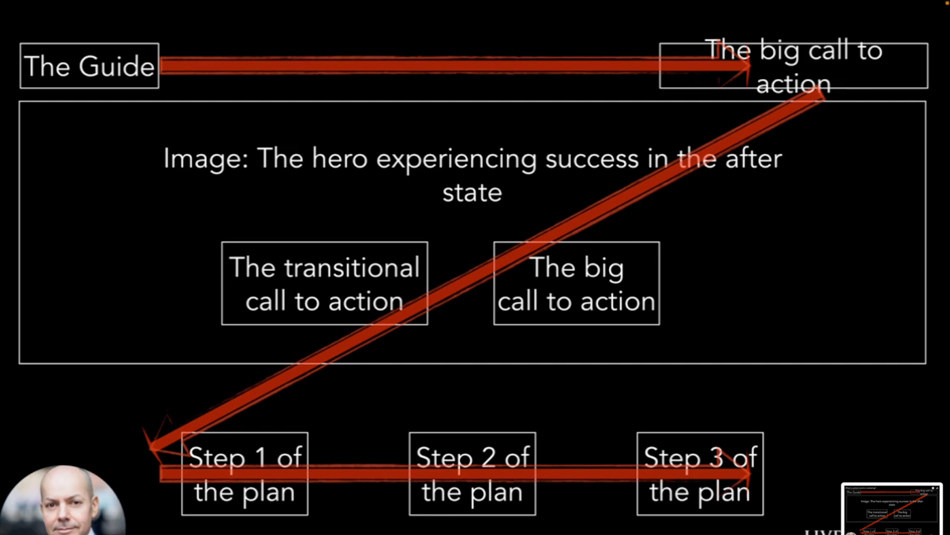
So the guide is on the very left. That’s typically where the logo is.
And by the way, you’re not supposed to be the biggest thing on the website.
I can’t tell you how many times I’ve heard from people “can you just make my logo a little bit bigger?”
Because that’s what’s going to make the hero go “uh, this isn’t about me.”
As soon as I hear somebody say that, can I, can, can you ‘biggify’ my logo?
I genuinely start to lose hope. Because I’ve told them that they’re not the hero of the story. And they’re just slipping right back into their patterns and trying to make it about themselves.
And it’s not about them. It’s about the patient. It’s like, “oh shoot. Now I have somebody who’s not patient-centric” (That’s what I think to myself).
Now on the right-hand side, you have the big call to action, right? Typically that’s ‘book an appointment’ and you make it easy, right?
That’s what being patients, patient-centric’s about. Right? Make it really, really available. That call to action has to be, you know, they have to be able to take it on.
Then the image here (the hero) – by the way – in marketing, they call this the hero image. I wonder why?
This is where you put the hero experiencing success in the after state, right? Ask yourself: “what would my ideal patient want to do a few days or weeks after a successful surgery?” Okay? That’s what you want to show in that image.
What do I often see?: Lasers, buildings, doctors. Wrong, wrong, wrong. Patients go there, enjoying themselves.
It’s not patients having surgery either. That’s the travel, right? You don’t sell transportation. You sell the destination.
Then you have the transitional call to action.
That’s typically a step towards the big call to action. So if they’re not quite ready to take the big leap, they can just take a small step and, you know, move down the path. Right?
The journey of a thousand miles begins with the first step.
So that’s the first step right here.
That’s typically like a self test or a guide download. That’s what we find works best. And then you have the big call to action.
And you will notice that in almost every single website we design, you’ll see this pattern. It’s a Z-pattern. The eye starts here:
“Who is this? Who’s talking to me? The guide. Okay, good. So I’m going to move down here now.” And the eye moves over here. The big call to action.
“Okay. They want me to do this. Okay. Got it. Clear.”
Then, see here, a line that goes diagonally and here in the image, it says the hero experience success in the after state, and really the headline needs to speak to that as well:
“Have an amazing life after vision correction, right? Change your life, right. Be free from the constraints of glasses and contact lenses”
That’s the kind of thing.
Then they see that transitional call to action here. Again, it’s usually a self test, but we don’t emphathize that. We usually set that a little bit more in the background. We often use a ghost image for that, which kind of looks like the background.
And then here, the big call to action. That’s the big, bold button that looks exactly like that one because it’s repetition. And we’re trying to repeat the call to action and make it clear. This is what’s important here.
Then we go to step one of the plan. Step two of the plan. Step three of the plan. Okay. That’s typically how we go with this is “how it works” container.
Step one, you give us a call. Step two, you come in for an appointment. Step three, you live a wonderful life.
That’s it. Super easy. One, two, three. Call us. Come in. Enjoy your life. It’s that simple.
There’s variations of this, depending on what it is that you are selling, what it is you’re offering, but this works in the majority of vision-correction websites, plastic surgery websites, and dental make-over websites.
You name it. If they want to give somebody a big change to their life, this is how it’s going to work. This is what really, really does work. And some people might go, “you know what? Your websites look a lot the same. I want mine to be different.”
That’s like me hoping that my surgeon walks into the operating room and just decides to be creative that day, as opposed to following the process that always works (I think I know which one you’d prefer). So, this is how this works;
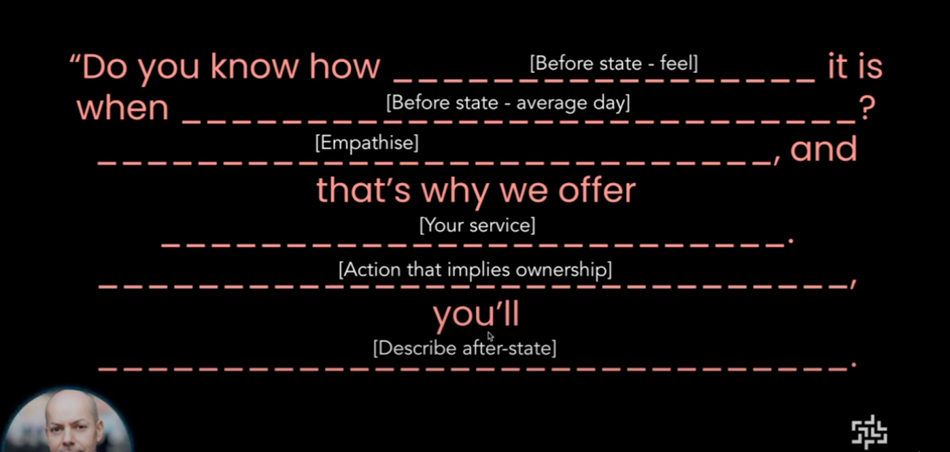
1.Before State
“Do you know how you are living with glasses and you really hate it?“And they really put a big downer on your life and it’s really inconvenient and the contacts cause you dry eyes and they give you infections.
You know what that’s all like? Yeah, that’s horrible. Right?”
2.Before State – average day
“You know what it’s like when you have to wake up in the morning and put your contacts in, or you might not find your glasses because you lose them all the time and now you’re late for work.”
“Every single day you’re thinking about, “Oh my God, my eyes are feeling dry and they’re sore and they’re red and do I look my best?
3.Empathise
Then you empathise with that. “Yeah we know how that feels. We’ve met a lot of people like that and that’s why we offer vision correction in our city”. Right?
4.Your service
This is where your SEO guy can get happy because you can say here, ‘laser eye surgery in London’, for example. They’re going to love that when you say, “yeah, put laser eye surgery in London, in there”, they’re going to be like, “yeah, thank goodness!”. We can put some SEO juice in there. All right? All right.
“You know how it really sucks to have glasses?
Well “how [do] you deal with that every day? Day in, day out? How does it get in your way?
Well, we get that. We understand, we totally appreciate that. We’ve seen lots of people in that same boat. That’s why we offer laser vision correction in London.”
5. Action that implies ownership
“And when you have laser eye surgery with us…”
6. Describe after-state
“You will not have to have those terrible days again, you will not have to wear glasses every single day.
You will be free of your contact lenses that cause you all that pain and discomfort”. All right?”
So that’s how you do this.
You empathise with their ‘before’ state, give them some examples so that they can relate to it. Show them that you relate to it, empathize with their challenges.
Tell them “that’s why you offer your service”. Give them a bit of an action and implies ownership. It could be, for example, when you just book an appointment with us, you’ll know exactly how to get the surgery. You’ll know exactly whether or not you’re suitable.”
Okay? That’s the basic model and framework that we want to have. And we want to repeat that message on an ongoing basis throughout your marketing materials.
Applications
Now, the applications of this are many. You can put this on;
- Ad images
- Copy
- Social media images and their copy
- Videos
- SEO
- Website headlines, images & copy
- Homepage elements
- Lead magnets, handouts, printed materials (you can do it on self-tests if you want)
- Telephone consultation process (you know you can get your people to say this stuff)
- In clinic marketing
All of that, right? Basically the point is it applies everywhere. There’s no place I can imagine you wouldn’t follow this approach, right? If [you] truly are genuinely patient centric, that’s what you do.
Compare these laser eye surgeon’s websites: patient-focused or brand-focused?
I ❤️LASIK
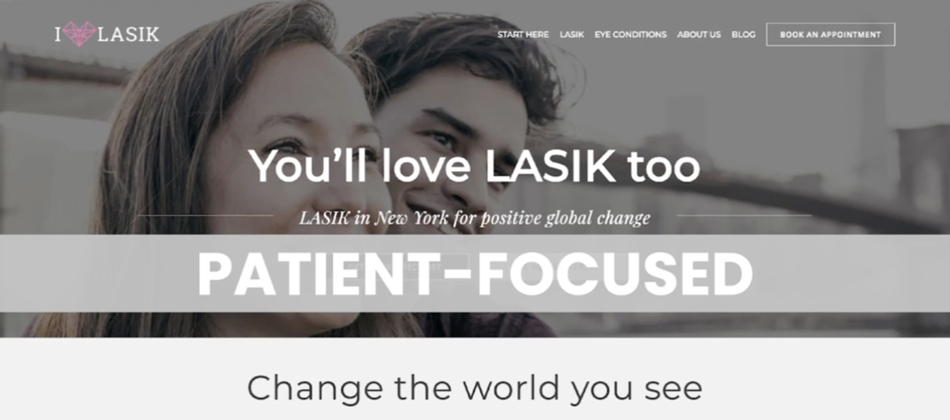
Now, this site. You can see it’s patient focused, right? “You’ll love LASIK too”. And here’s a “LASIK in New York for positive, global change” saying, “change the world you see” right?
Pretty picture of a couple of past patients enjoying their lives. So that’s patient-focused.
Optegra
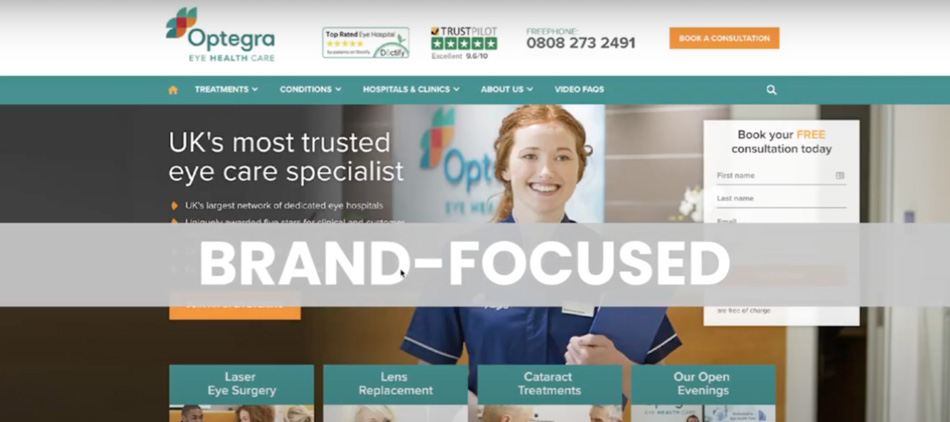
Here’s another one.
“UK’s most trusted eye care specialist”. Well, yeah. Great. And you know, who’s that about? Is that about the patient?
No. None of these bullet points are. Who is this? Is that a patient? No. That’s a nurse. Lovely looking nurse, but no. Brand-focused.
Right?
Then the patients gets to play secondary supporting characters here. Right. And not even fully, here’s a surgeon and here’s a doctor, right? So the patient is kind of in the background. They’re the supporting character. The hero is this nurse and this brand, not the way to go. And there’s no lead magnet. Notice that there’s no small step, there’s either ‘join us for an open evening’. Okay. We could consider that that’s a smaller step than ‘book a free consultation’.
Laura Crawley
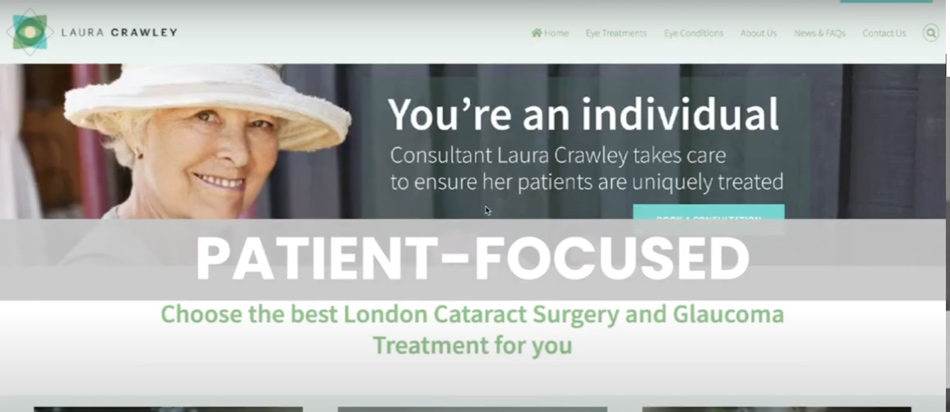
Here’s another one. “You’re an individual”. “Consultant Laura Crawley takes care to ensure her patients are uniquely treated”. This could be worded in a little bit more patient-centric way. But at least it begins with “you’re an individual” it’s talking to ‘you’ to a patient.
I would also include a lead magnet, some kind of self test or a guide that would help a lot. But it’s patient-centric.
AVC
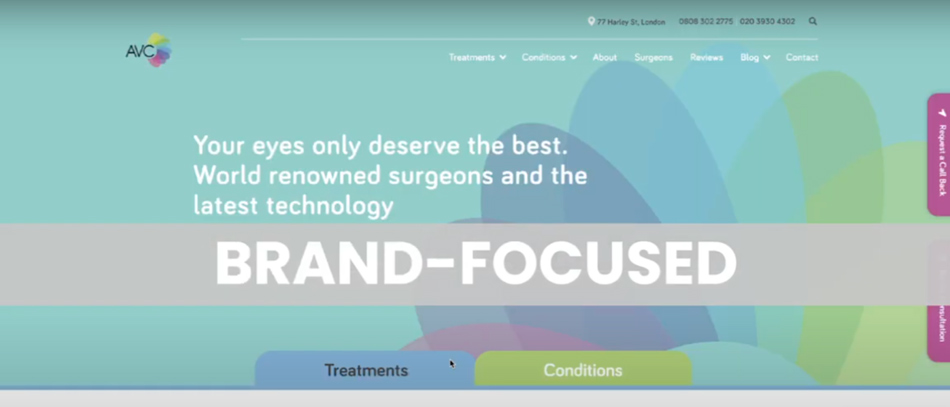
This one ABC totally brand-focused. “Your eyes only deserve the best”. Who are we talking about? Oh, the best being ABC. Okay..
“World-renowned surgeons. And the latest technology”. Hundred percent brand focused. Patient’s not even in the picture, it’s all just logo, brand, a big logo here.
No patient anywhere to be seen. Do they even treat patients? who knows? Not anymore.
Custom Vision Clinic
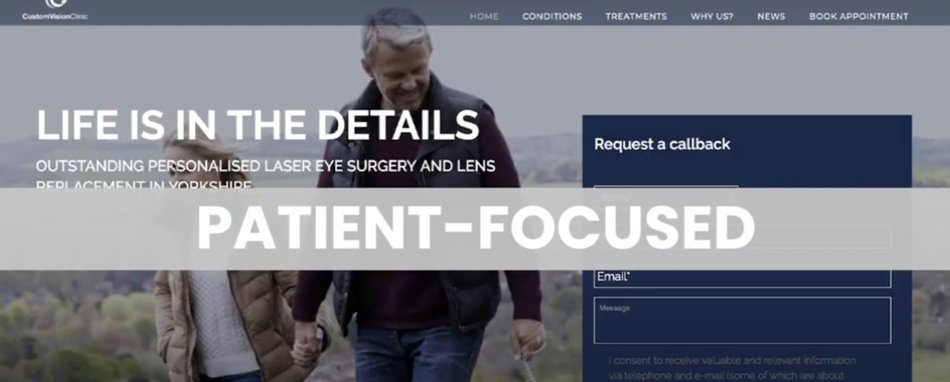
“Life is in the details. Outstanding, personalised laser eye surgery and lens replacement in Yorkshire”.
This is, this could be better. It’s patient-focused because it has an image of a patient here, potentially.
It’s this person they’re walking their dog in the Yorkshire Dales. This could be better. And also the lead magnet I think, has been added later, but I would actually probably add it here.
And this isn’t so much of a real lead magnet at all. So I’d remove that. But I liked the “book of appointment” here.
By the way, this is a site we built years ago, and I’m critical of our old work.
And if you’re not critical of your old work, then you’re not improving. So yeah, I would definitely go back and fix this.
London Vision Clinic
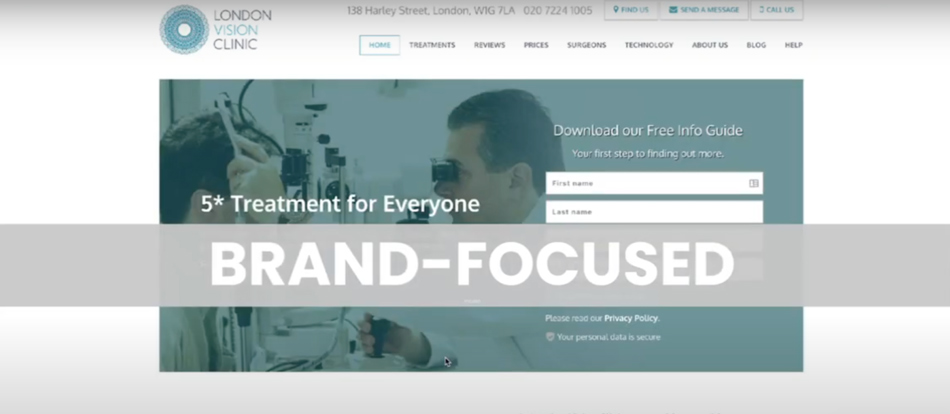
London Vision Clinic is perceived as expert surgeons who are really, really good at what they do, and they are.
But this website is brand-focused.
It’s not patient focused. Okay. It’s like “Laser eye surgery at London Vision Clinic… trusted experts”, right? “Five star treatment for everyone”. Yeah, no, this is brand-focused.
Focus

“Your eyes are precious”. Fair enough. I think we all knew that? I should hope so!
“We are the UK’s only clinic with a published hundred percent success rate”. Hundred percent brand-focused. Right? There’s the image of the doctor. You can’t see it here, but there’s the image of the doctor.
Eyesight
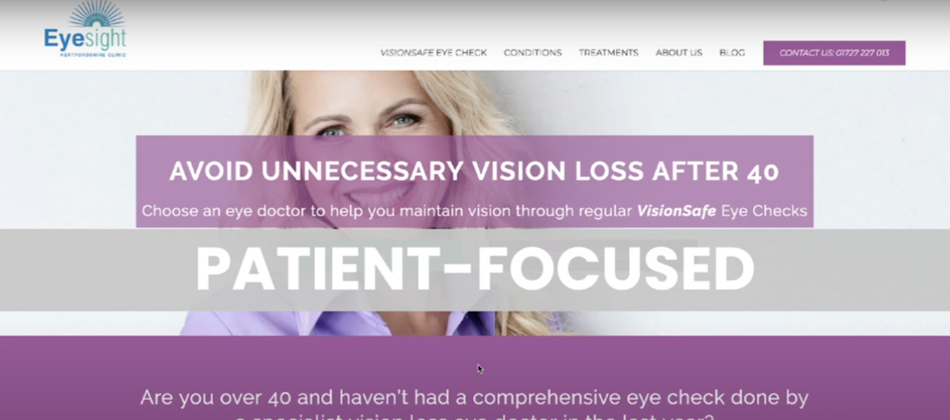
Here’s the one that’s patient focused. “Avoid unnecessary vision loss After 40. Choose an eye doctor to help you maintain vision through regular vision, safe eye checks”.
So this is patient focused.
I think there’s a lead magnet in here, somewhere on behind my banner. But yeah, this is more patient-focused.
Who is the hero in your copywriting, your design, your marketing, your customer, or your brand?
Is it you? or is it the patient? Better make it about the patient because they’re not going to pay attention if it’s you.
Patients aren’t looking for another hero.
They want to be the hero. They want to be the hero.
The more you talk about you, the more space you take up, the more time you take up talking about you, the less they care, the more they tune out, focus on who they are, focus on them being the hero.
The hero is looking for a guide.
Your job is to be that guide.
Okay? That’s it. That’s the talk.
I hope it sinks in. I hope you learned something here. I hope it makes a difference. And if you need help in reviewing your materials, your approach, your messaging, to determine whether or not you’re doing this right.
Reach out, give us a call and we’ll be happy to have a discussion about it. Thanks very much! Bye. For now.
NOTE: The best way to answer that nagging question about practice growth or marketing or patient volume in the back of your mind is to book a free 15-minute compatibility call. Get some options and go away with a clear idea of what’s possible.
About the author
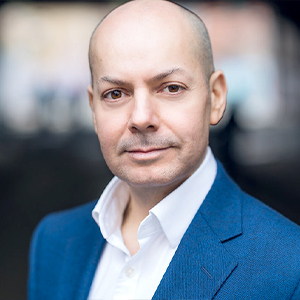
Rod Solar
Founder & Fractional CMO
Rod co-founded LiveseySolar and acts as a Fractional CMO for our customers. He’s on a mission to help transform the lives of 10,000 people through vision correction surgery by 2024. To achieve that, he inspires his customers to make confident decisions that will help 50,000 people take the first step towards vision correction.
Related Posts
Meet our Founders

Rod Solar
Founder & Scalable Business Advisor
Rod Solar is a co-founder of LiveseySolar and a Scalable Business Advisor / fCMO for our customers. Rod mentors and coaches CEOs/Founders and their leadership teams to triple their sales, double their profit, and achieve their “ideal exit”.
LiveseySolar completely transformed the way we were approaching this… We’ve gone from having just the dream of having a practice to having a practice up and running with people making inquiries and booking for procedures… It’s extremely pleasing. We feel lucky we connected with LiveseySolar.
— Dr Matthew Russell, MBChB, FRANZCO, specialist ophthalmic surgeon and founder of VSON and OKKO

Laura Livesey
Founder & CEO
Laura Livesey is the co-founder & CEO of LiveseySolar. She has developed powerful refractive surgery marketing systems that increase patient volumes and profits for doctors, clinics, and hospitals, since 1997.
Rod and Laura know as much about marketing surgery to patients as I know about performing it. They are an expert in the field of laser eye surgery marketing. They know this industry inside out. I believe that they could help many companies in a variety of areas including marketing materials, sales training and marketing support for doctors.
— Prof. Dan Reinstein, MD MA FRSC DABO, founder of the London Vision Clinic, UK






